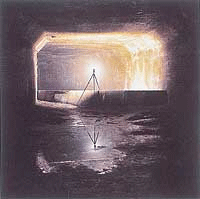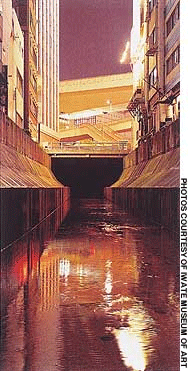Let there be light in the urban darkness
September 4, 2002
NAOYA HATAKEYAMA
Let there be light in the urban darkness
By KATE THOMSON
Special to The Japan Times
Naoya Hatakeyama's stunning photographs use finely tuned modern techniques to discover harmonious beauty in places where we often perceive only competing layers of chaos. They filter our all-too-familiar environment, revealing its underlying complexity and, in the process, leading us to question the true "nature" of the world and our place in it.

Naoya Hatakeyama's photographs, such as "Underground" series (2000) and the "Untitled 1989-2001" series (below) illuminate man's relationship with nature.

This is a well-organized exhibition (at the Iwate Museum of Modern Art in Morioka until Sept. 16 before traveling to Osaka) which leads the viewer through the development of Hatakeyama's ideas to the realization that man and nature are still inextricably linked; that the organic still lingers within the constructed. This chain of reasoning finds its finale in the dramatic shots of the "Lime Hills" series (1991-94), showing the raw material for our concrete jungles being blasted from the mountainside. Even our most ambitious constructions, we are reminded, will one day return to calcium carbonate dust.
Walking into the first gallery gave me the peculiar sense of having been transported home to a British housing-development showroom. It turns out that these slick photographs are from Hatakeyama's time as an artist-in-residence in Milton Keynes, a notoriously banal "new town" north of London. These works could have perhaps been left out of the exhibition, as they merely serve to preface the following series, "Slow Glass" (2001), in which monotonous subject matter is transformed by being photographed through a screen of water droplets.
The "Slow Glass" photographs possess an abstract sense of rhythm and color. I was intrigued by the way the droplets break up the original image into hundreds of perfect copies, sharply focused in the foreground. This "fly's eye" view suggests the repetition of identical scenes in our increasingly unimaginative built environment, while the viewer is simultaneously seduced by the perfect complexity exposed in each tiny drop.
Hatakeyama has carefully developed these prints which, like all his photographs, seem to celebrate the fact that it is light that exposes color, contour and texture. It became fascinating to try and discern whether the almost duotone effect of these pictures was created directly on the film or by using digital technology in the processing. This search for clues in a still image brings home how our brains usually edit out much of the visual information we are bombarded with at every moment, in order to focus on the relevant. The "Slow Glass" series would have perhaps been more challenging if only a section of the negative were printed, so that the fragment teased us for a little longer without allowing the whole image in the background to distract us into recognition so soon.
The "River Series" (1993-94) deploys another clever optical diversion that forces the viewer to look more closely. Tokyo, in all its concrete and neon glory, is shown reflected in the canals running through the city. Images that at once highlight the similarity and the peculiarity of different scenes catch the eye with their perfect horizontal line between the city and its ethereal reflection in the canal. This horizontal is a trick, though -- it is actually the join between two photographs of the scene.
The next series, "Untitled 1989-2001," switches from this ground-level view to show aerial cityscapes. The prints contain an excess of detail, forcing the viewer to "abstract" the image. Closer inspection reveals that a number of the prints repeat the same scene in different seasons and over a period of time, showing the incredible speed with which the cityscape changes.
Having become used to the artist's aim of making us reassess our perception of the world around us, the viewer is drawn into an unknown world hidden beneath the city in the "Underground" (2000) series. These images of secret places offer layers of suggestion, as the artist creates color and texture simply by mounting a photographer's light on a tripod in the center of the composition. There is a sense of being a privileged witness to a dangerous beauty created by the temporary illumination of these cavernous spaces, while we share the privacy and cloistered safety of the dark recess occupied by the camera. These fascinating spaces, we know, will disappear back into anonymity once the light source is removed.
As a coda to these magical images of dark, damp spaces are three pictures that transform repugnant subjects from the underground -- such as rat feces and mold on sewage -- by highlighting their array of color and texture, once more challenging the viewer's preconception of the subject.
The black-and-white "Maquettes/Light" (1995-97) series, in which photographs are displayed in illuminated box frames, takes to an almost sculptural degree Hatakeyama's skill for revealing depth in a 2-D image. Although it is obvious what their subject matter is -- tower blocks at night -- these works are gorgeous abstract studies of ghostly light shining through concrete and steel.
The "Lime Works" (1986-90) series discovers dynamic compositions of color, structure and form in the industrial plants that process limestone into concrete. These striking images are expressions both of power and of vulnerability; part futuristic stage set, part archaeological dig; Impressionist, Expressionist and Constructivist.
"Lime Hills" shows the landscapes from which the limestone is quarried, and its followup, "Blast" (1997-99) gives appropriate closure for the exhibition, too. Serial shots of blasted limestone -- the raw material for the concrete used to create the buildings and tunnels which are Hatakeyama's photographic subjects -- are dramatic revelations of the power of both man and nature.
As a sculptor working in stone, I am already familiar with the incredible beauty of a stone quarry, and the way nature still dwarfs the intrusions man makes into the environment. As Hatakeyama's photographs show, this young Iwate-born artist who has worked and exhibited throughout Japan, America and Europe has a very real talent for identifying the true "nature" of our environment, both the natural and man-made.
Hatakeyama's works are not simply representations of reality (or attempts to record a moment in time), but tools to help us investigate its endless manifestations. They are also, in the "Underground" and "Maquettes/Light" series in particular, beautiful works of art. This is the first major exhibition of contemporary art at the Iwate Museum of Art, which opened just 10 months ago, and it is wonderful to see work of this quality in my own region before it travels to a major city gallery.
Naoya Hatakeyama shows till Sept. 16 at the Iwate Museum of Modern Art, 12-3 Matsuhabe, Motomiya, Morioka, Iwate; call (019) 658-1711 or visit www.ima.or.jp for more information. The exhibition then travels to the National Museum of Art, Osaka, Nov. 7-Dec. 17.
The Japan Times: Sept. 4, 2002
(C) All rights reserved